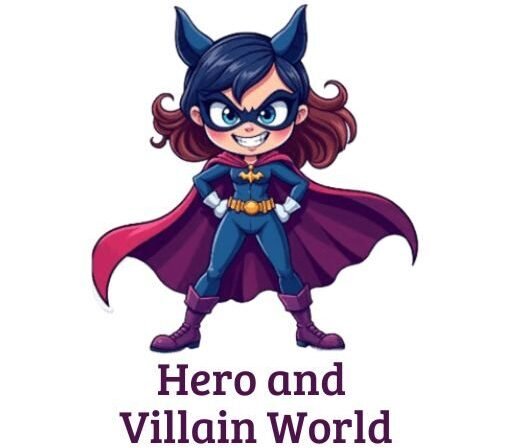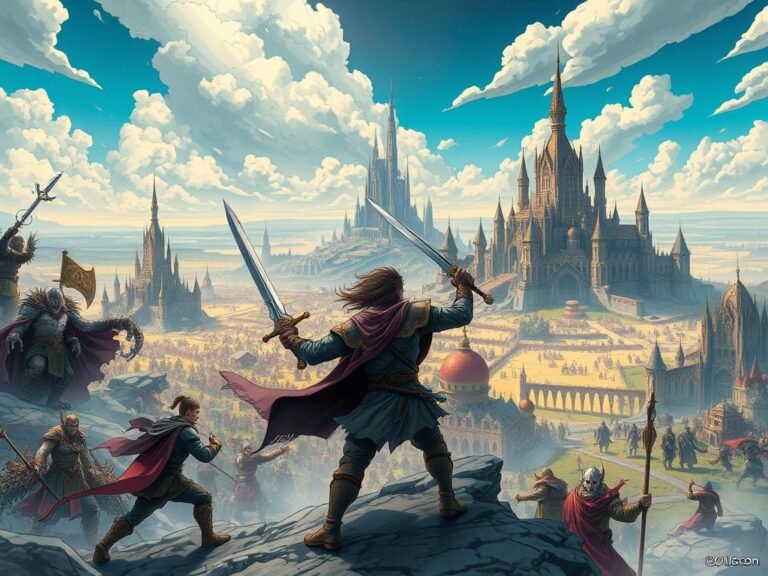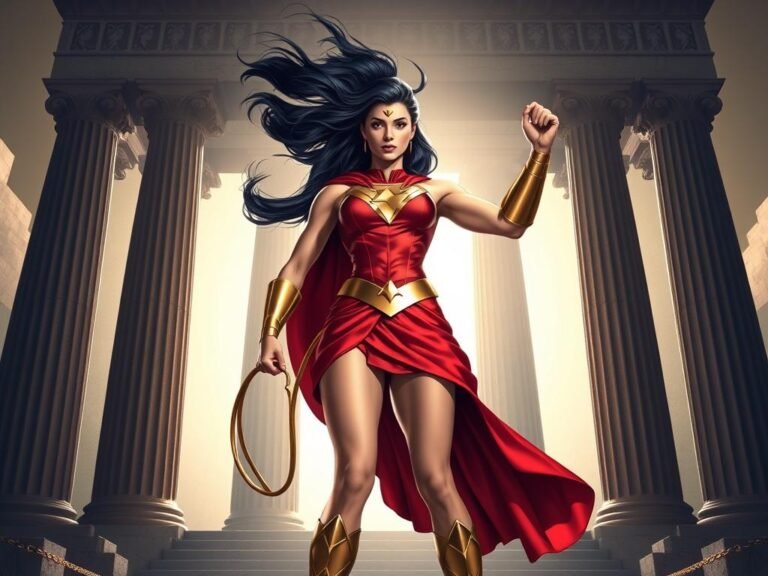Innovations and Challenges in Modern Comics

Innovations and Challenges in Modern Comics: Ever since I was a kid, comics have been my escape. The vibrant art, the gripping stories, and the way they transport you to another world—it’s magical.
Over time, I’ve watched this medium evolve from simple newspaper strips to a dynamic, multimedia industry. My love for comics has only grown stronger.
Today, the comic book industry is thriving like never before. Digital platforms like Webtoon and ComiXology have revolutionized how we consume stories.
Graphic novels have gained recognition as a respected art form, blending complex narratives with stunning visuals. The rise of interactive storytelling and multimedia elements has made comics more immersive than ever.
But with growth comes challenges. The shift to digital has brought new opportunities, but also questions about sustainability and accessibility.
As we dive into this article, we’ll explore the historical roots, creative processes, and market trends shaping the future of comics. Let’s celebrate this incredible medium together.
Introduction: My Journey into the World of Comics
From the moment I picked up my first comic, I was hooked. The vibrant colors, larger-than-life characters, and action-packed scenes drew me in instantly.
I remember flipping through the pages, captivated by the way the images and text worked together to tell a story.
As a young reader, I was fascinated by characters like Superman. His strength and heroism made me believe in the power of good.
Those early experiences shaped my understanding of what a comic book could be—a medium that blends art and narrative in a unique way.
Over time, I began to explore different genres. From superhero tales to slice-of-life stories, each one offered something new. I realized that comics weren’t just for kids—they were a powerful art form.
The creators behind these works were storytellers and artists, weaving complex narratives with every panel.
This journey into the world of comics has been incredible. It’s not just about the characters or the art—it’s about the way this medium evolves.
From its humble beginnings to its current status as a respected art form, comics continue to inspire and captivate. As we move forward, I’m excited to explore the history and impact of this amazing medium.
Historical Foundations of Visual Storytelling
Long before comics became a global phenomenon, visual storytelling had ancient roots. From Egyptian hieroglyphics to Roman frescoes, early civilizations used sequential art to convey stories and ideas.
These ancient forms laid the groundwork for what we now know as the comic.
Fast forward to the late 19th century, and the modern comic began to take shape. Newspaper strips like “The Yellow Kid” became wildly popular, blending humor with visual narratives.
This era, known as the Golden Age, marked the rise of the strip as a powerful storytelling medium.
Characters from these early strips played a pivotal role in shaping narrative forms. They captured the imagination of readers and set the stage for the evolution of the comic book.
Over time, the term “comic book” came to describe not just humorous stories but complex narratives spanning multiple pages.
The influence of these early formats is still felt today. From the way stories are structured to the role of the writer, the roots of visual storytelling continue to inspire modern creators.
For a deeper dive into this fascinating history, check out this detailed timeline.
- Superior Protection: Entrust your modern-era comic book collection to these comic book hard sleeves, meticulously design…
- Fits Most Comics: These modern/current comic book protector sleeves are tailored to accommodate individual issues from 1…
- High-Quality Rigid PVC Crafted from high-quality, crystal-clear rigid PVC, our rigid comic top loaders provide a pristin…
The Birth of the Superhero Genre
The superhero genre changed the comic world forever when Superman first appeared in 1938. This groundbreaking moment marked the beginning of a new era in storytelling.
Superman, with his incredible powers and moral compass, became the blueprint for future characters.
Action Comics #1, where Superman debuted, was a turning point in comic history. It introduced readers to a character who fought for justice and inspired hope.
This issue not only launched the superhero genre but also set the stage for other iconic heroes.
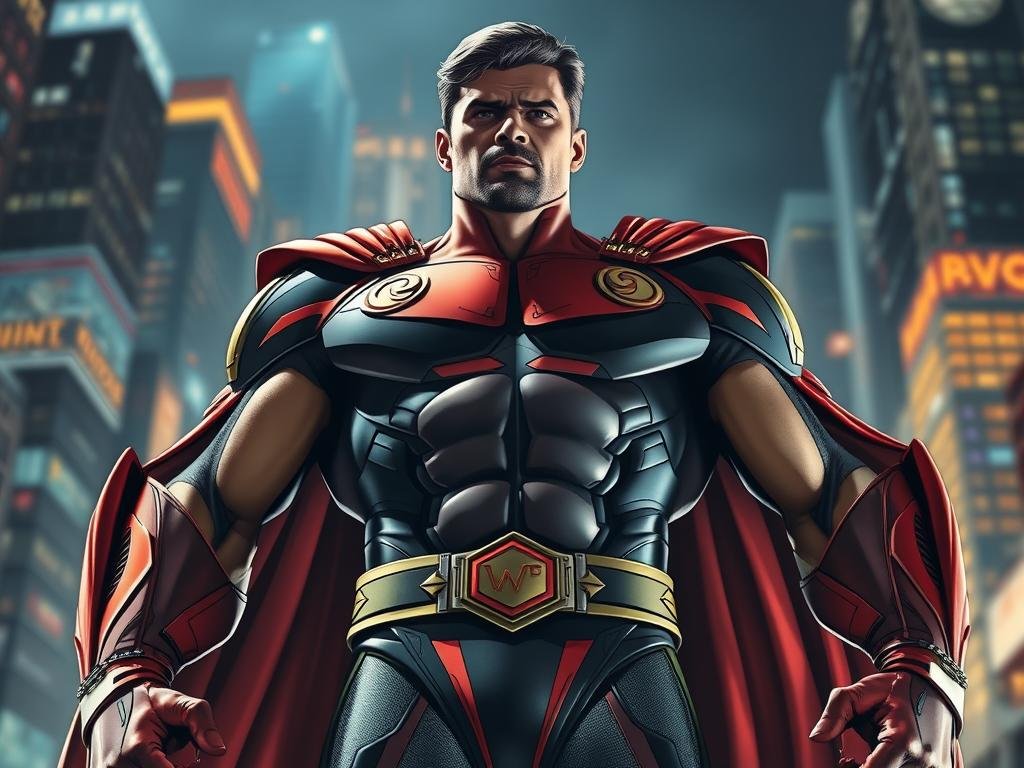
Following Superman’s success, other heroes like Batman and Wonder Woman emerged. These characters brought diversity to the genre, each with unique abilities and stories.
Their debut issues captured the imagination of readers and solidified the popularity of superheroes.
The early years of the genre were filled with creative risks. Creators experimented with new ideas, blending action, drama, and fantasy.
These innovations laid the foundation for the modern comic industry.
Looking back, the birth of the superhero genre was a pivotal moment in history. It transformed comics from simple strips into a global phenomenon. Today, these early heroes continue to inspire new generations of readers and creators.
Iconic Characters and Their Debut Moments
The Golden Age of comics introduced some of the most beloved characters in history. Here’s a look at their debut moments:
| Character | Debut Issue | Year |
|---|---|---|
| Superman | Action Comics #1 | 1938 |
| Batman | Detective Comics #27 | 1939 |
| Wonder Woman | All Star Comics #8 | 1941 |
These debut moments not only defined the genre but also shaped the world of comics. Each issue brought something new, pushing the boundaries of storytelling and art.
The legacy of these early heroes is undeniable. They remain a testament to the creativity and vision of their creators. As we celebrate their impact, it’s clear that the superhero genre will continue to evolve and inspire.
Innovations and Challenges in Modern Comics
The comic book industry is constantly evolving, blending tradition with cutting-edge creativity. Today, digital platforms have transformed how we experience stories.
Interactive elements and extended narratives are pushing the boundaries of what a comic can be.
One of the most exciting developments is the rise of digital interactivity. Platforms like Webtoon allow readers to engage with stories in new ways.
This shift has opened doors for creators to experiment with multimedia elements, making the reading experience more immersive.
However, this evolution comes with its own set of challenges. The shift to digital has raised questions about accessibility and sustainability.
While some readers embrace the convenience, others miss the tactile experience of holding a comic book in their hands.
The industry is also adapting to changing reader expectations. Graphic novels, for example, have gained significant traction.
Their longer formats allow for deeper storytelling, appealing to a broader audience. This trend highlights the versatility of the medium.
Creators and publishers face economic pressures as well. The pandemic forced many to rethink distribution strategies. Initiatives like #Creators4Comics provided much-needed support, showcasing the resilience of the comic community.
Despite these challenges, the industry continues to thrive. Creative risks are being taken, leading to groundbreaking works.
For instance, DC Comics’ shift to Tuesday releases and new distribution practices demonstrate adaptability in a competitive market.
Here’s a look at some modern creative risks and their outcomes:
| Creative Risk | Outcome |
|---|---|
| Digital-first releases | Increased accessibility and global reach |
| Extended graphic novel formats | Deeper storytelling and broader appeal |
| Interactive storytelling | Enhanced reader engagement |
Balancing tradition with experimentation is key. While I appreciate the innovation, I also value the classic elements that made me fall in love with comics. The impact of these changes is undeniable, shaping the future of the medium.
As the industry moves forward, it’s clear that creativity and adaptability will drive success. Whether through digital platforms or graphic novels, the world of comics continues to inspire and captivate.
Pioneering Formats: Comics vs. Graphic Novels
Exploring the evolution of storytelling, I’ve always been fascinated by how comics and graphic novels differ. While both share a visual narrative style, their format and approach to storytelling set them apart.
Understanding these differences helps appreciate the unique strengths of each medium.
Differences in Length and Narrative Structure
Traditional comics often follow a serialized format, with stories unfolding across multiple issues. This episodic approach keeps readers engaged over time. In contrast, graphic novels are typically standalone works, offering a complete story in one book.
The narrative structure also differs. Comics rely on shorter, self-contained arcs, while graphic novels delve into complex, multilayered plots. This allows for deeper character development and thematic exploration.
Transitioning from Serial Comics to Standalone Graphic Novels
The shift from serialized comics to graphic novels began in the 1970s, with works like Will Eisner’s “A Contract with God.” This marked a turning point, as creators embraced longer formats to tell more intricate stories.
I remember my first experience with a graphic novel. It felt different from reading a comic strip—more immersive and complete. The ability to explore complex themes in a single book was a game-changer.
Today, graphic novels span diverse genres, from memoirs to fantasy. Works like “They Called Us Enemy” by George Takei showcase the medium’s power to address historical and personal narratives.
For more on the evolution of comics, check out this detailed timeline.
The Creative Minds Behind the Panels
Behind every great comic lies the genius of its creators. These visionaries bring stories to life, blending art and narrative in ways that captivate readers.
From the writer crafting the script to the artist designing each panel, their collaboration shapes the soul of every story.
I’ve always admired the dedication of these creators. Their ability to weave complex tales within the confines of a panel is nothing short of magical. Take, for example, Alan Moore and Dave Gibbons’ “Watchmen.”
Their groundbreaking work redefined the genre, proving that comics could tackle profound themes with depth and nuance.
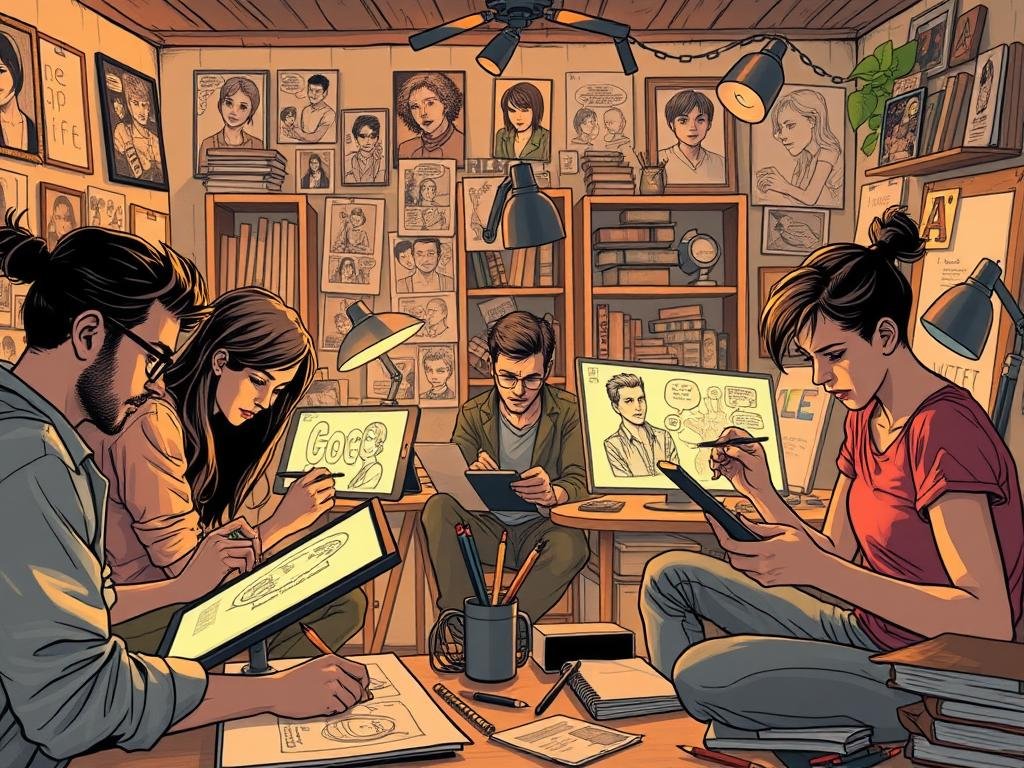
Influential Writers and Artists
The comic medium owes much to its pioneers. Stan Lee and Jack Kirby’s partnership at Marvel introduced iconic characters like Spider-Man and the X-Men. Their innovative storytelling techniques set new standards for the genre.
Similarly, artists like Will Eisner revolutionized visual storytelling. His work on “The Spirit” showcased the potential of panels to convey emotion and movement. Eisner’s influence is still felt today, inspiring a new generation of creators.
“Comics are a unique blend of art and literature, where every line and word matters.”
Collaboration is key in this industry. The relationship between writer and artist often determines the success of a comic.
For instance, Frank Miller’s gritty narratives paired with David Mazzucchelli’s bold art in “Daredevil: Born Again” created a masterpiece that continues to resonate.
Here are some groundbreaking techniques that have shaped the comic industry:
- Sequential storytelling: Using panels to guide the reader’s eye and pace the narrative.
- Visual metaphors: Enhancing themes through symbolic imagery.
- Dynamic layouts: Breaking traditional panel structures for dramatic effect.
These innovations remind us that comics are more than just entertainment—they’re an art form. As I reflect on the work of these creators, I’m inspired to continue exploring the limitless possibilities of this medium.
Impact on Culture, Education, and Personal Growth
Comics have always been more than just entertainment for me—they’ve been a gateway to understanding the world.
Through their vivid storytelling and unique blend of art and text, they’ve shaped my perspective on art, culture, and even personal growth.
Their impact extends far beyond the pages, influencing education and societal discourse.
Comics as Learning Tools and Cultural Catalysts
One of the most remarkable aspects of comics is their ability to improve literacy and spark creative thinking. Research shows that combining words and visuals enhances comprehension, making them powerful tools for education.
I’ve seen firsthand how they engage readers, encouraging them to explore complex ideas in an accessible way.
In classrooms, comics are being used to address social issues like race and gender. Works like “They Called Us Enemy” by George Takei provide a platform for critical conversations.
These stories not only educate but also foster empathy, allowing readers to see the world through others’ eyes.
Beyond education, comics serve as cultural touchstones. They reflect societal values and challenge norms, often becoming vehicles for social commentary.
For example, the “Remember” Comics Project highlights Indigenous storytelling, preserving local customs and traditions. This cultural richness makes comics a vital part of our shared heritage.
“Comics democratize access to narratives, reframing them in new media with innovative interpretations.”
Here are some ways comics enrich our lives:
- Improving literacy: Visual storytelling helps readers of all ages develop reading skills.
- Fostering empathy: By exploring diverse perspectives, comics build understanding and compassion.
- Encouraging creativity: The blend of art and narrative inspires readers to think outside the box.
As I reflect on the role of comics, I’m reminded of their power to transform. They’re not just stories—they’re tools for learning, bridges between cultures, and catalysts for personal growth.
Their impact continues to shape the way we see the world and ourselves.
The Evolution of Digital Comics
The way we experience comics has transformed dramatically over the years. From flipping through physical pages to tapping on screens, the shift from print to digital has reshaped the medium.
This evolution isn’t just about convenience—it’s about redefining how stories are told and consumed.
From Print to Interactive Platforms
I remember the first time I discovered digital comics. It was a game-changer. Platforms like Webtoon and ComiXology introduced me to a new world of storytelling.
These platforms didn’t just replicate print comics—they enhanced them with interactive elements like clickable panels and animated sequences.
One of the most exciting aspects of digital comics is their accessibility. Creators no longer need to rely on traditional publishing routes.
They can share their work directly with readers, bypassing barriers that once limited their reach. This democratization has led to a surge in diverse voices and stories.
“Digital comics have opened doors for creators, allowing them to experiment and connect with audiences in ways that were once impossible.”
Here’s a look at how digital platforms have reshaped the comic industry:
| Platform | Key Feature | Impact |
|---|---|---|
| Webtoon | Vertical scrolling format | Enhanced mobile reading experience |
| ComiXology | Guided View technology | Optimized for small screens |
| Tapas | Micro-transactions | Supported independent creators |
My own journey with digital comics has been eye-opening. The ability to explore stories from around the world, often for free or at a low cost, has broadened my perspective.
It’s a testament to how technology can bring people together through shared narratives.
As the medium continues to evolve, I’m excited to see where it goes next. Whether through virtual reality or new storytelling techniques, the future of comics is digital—and it’s just getting started.
The Rise of Webcomics and Independent Voices
The internet has given rise to a new era of storytelling through webcomics. These digital platforms have empowered independent creators to share their unique visions with the world.
Unlike traditional comic publishing, webcomics offer a direct way to connect with readers, bypassing barriers like costly print runs.
One of the most exciting aspects of webcomics is their accessibility. Platforms like Webtoon and Tapas allow creators to publish their work globally.
This democratization has led to a surge in diverse voices and innovative series. From slice-of-life stories to epic fantasies, there’s something for everyone.
I’ve always admired how webcomics break traditional molds. Take Lore Olympus, for example. This series reimagines Greek mythology with stunning visuals and modern themes.
Its success shows how creators can push boundaries and reach millions of readers.
“Webcomics have opened doors for creators, allowing them to experiment and connect with audiences in ways that were once impossible.”
However, the journey isn’t without challenges. Many independent creators face issues like burnout and monetization.
Platforms like Patreon and crowdfunding campaigns have become essential for sustaining their work. Despite these hurdles, the passion and creativity in the webcomic community continue to thrive.
Here are some ways webcomics are reshaping the comic industry:
- Global reach: Creators can share their stories with audiences worldwide.
- Creative freedom: No gatekeepers mean more diverse and experimental narratives.
- Innovative formats: Vertical scrolling and interactive elements enhance the reading experience.
As I explore the world of webcomics, I’m inspired by the creativity and resilience of independent creators. Their work not only entertains but also challenges norms and fosters inclusivity.
The rise of webcomics is a testament to the power of storytelling in the digital age.
Technological Innovations Shaping Modern Comics
Technology has become a driving force in reshaping how we create and experience comics. From interactive storytelling to immersive media, these advancements are pushing the boundaries of what this art form can achieve.
As a lifelong fan, I’m thrilled to see how these tools are transforming the platform for both creators and readers.
Interactive Storytelling and Multimedia Elements
One of the most exciting developments is the rise of interactive panels. Digital platforms like Webtoon allow readers to engage with stories in ways that were once unimaginable.
For example, some comics now include clickable elements that reveal hidden details or trigger animations. This adds a new layer of depth to the reading experience.
Multimedia elements are also changing the game. Sound effects, background music, and even voiceovers are being integrated into digital comics.
These features make the stories more immersive, allowing readers to feel like they’re part of the narrative. It’s a testament to how technology can enhance the art of storytelling.
Emerging VR/AR and AI Applications
Virtual and augmented reality are taking comics to the next level. Imagine stepping into a panel and exploring the world of your favorite characters.
VR headsets and AR apps are making this possible, offering a truly immersive experience. For example, some creators are using AR to overlay digital elements onto physical pages, bringing static images to life.
Artificial intelligence is also making waves in the industry. AI tools can assist creators by generating art or suggesting storylines.
This not only speeds up the creative process but also opens up new possibilities for experimentation. It’s fascinating to see how these technologies are shaping the future of comics.
“Technology is not just changing how we read comics—it’s redefining how we experience them.”
As I reflect on these advancements, I’m excited about the potential they hold. Whether through interactive media or immersive VR, the future of comics is bright. These innovations are not just enhancing the art form—they’re revolutionizing it.
Economic Impact and Market Growth Trends
The comic book industry has always been a dynamic space, constantly adapting to new trends. Over time, it has grown into a multi-billion-dollar industry, with global revenues reaching $15.5 billion in 2022.
This growth is projected to continue, with estimates suggesting the market will hit $26.9 billion by 2032.
Traditional publishers like Marvel and DC Comics have long dominated the industry. However, digital platforms like Webtoon and ComiXology are reshaping the landscape.
These platforms offer creators new opportunities to reach audiences directly, bypassing traditional gatekeepers.
Monetization strategies have also evolved. Direct sales, subscriptions, and crowdfunding are now key revenue streams.
For example, platforms like Patreon allow indie creators to fund their work through fan support. This shift has democratized the industry, enabling diverse voices to thrive.
“The rise of digital platforms has opened doors for creators, allowing them to connect with audiences in ways that were once impossible.”
Despite these advancements, challenges remain. The shift to digital has raised questions about accessibility and sustainability. While some readers embrace the convenience, others miss the tactile experience of holding a comic book in their hands.
Here are some key trends shaping the comic book industry:
- Global reach: The Asia-Pacific region, particularly Japan, has seen significant growth, driven by manga’s popularity.
- Diverse genres: From superhero tales to slice-of-life stories, the industry is catering to a broader audience.
- Collectible value: Physical comics remain prized for their historical significance and artistic appeal.
As I reflect on these trends, I’m excited about the future of the industry. Whether through digital platforms or traditional publishing, the comic book industry continues to captivate and inspire.
Its ability to adapt and innovate ensures it will remain a vital part of our cultural landscape for years to come.
Global Perspectives on Comic Storytelling
Comics have always been a universal language, connecting people across borders. From Japan’s vibrant manga to America’s iconic superhero tales, this medium reflects the diversity of our world.
Each culture brings its unique voice, enriching the global comic landscape.
One of the most fascinating aspects is how storytelling techniques vary. Western comics often focus on action-packed narratives, while Eastern styles emphasize emotional depth and intricate plots.
These differences highlight the cultural nuances that shape the medium.
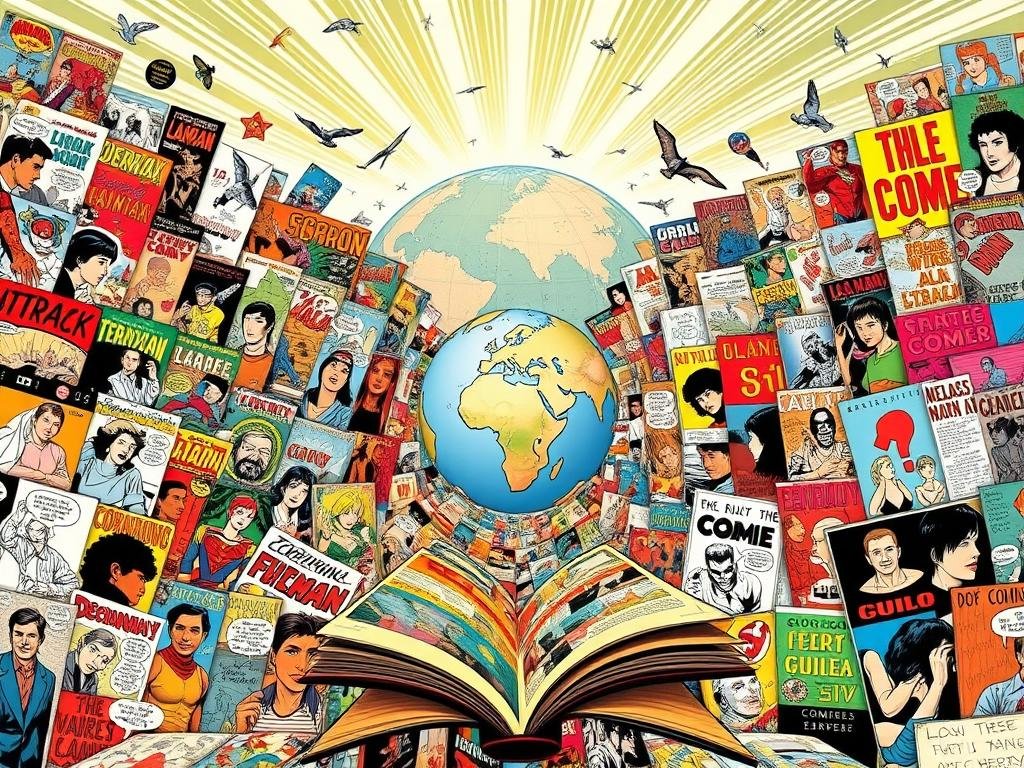
Global events also influence comic content. For instance, manga often reflects Japan’s societal values, while American comics address themes like justice and heroism.
This cross-cultural exchange broadens the audience and deepens the storytelling experience.
“Comics are a mirror of society, reflecting the hopes, fears, and dreams of their creators and readers.”
My own journey with global comics has been eye-opening. Discovering manga introduced me to new art styles and narrative techniques.
Similarly, European graphic novels like “Persepolis” offered a fresh perspective on personal and political struggles. These experiences remind me of the power of cultural exchange.
Here’s how global storytelling enriches the comic medium:
- Diverse narratives: Stories from different cultures offer unique perspectives.
- Artistic innovation: Varied art styles inspire creativity and experimentation.
- Broader audience: Cross-cultural appeal attracts readers from all walks of life.
As the comic industry continues to grow, this global exchange will remain vital. It’s not just about telling stories—it’s about building bridges between cultures.
Through comics, we can celebrate our differences and find common ground.
Changing Trends in Art Styles and Narrative Techniques
The way we tell stories through comics has evolved dramatically, blending tradition with fresh creativity. Over the years, I’ve noticed how art styles and narrative techniques have transformed, making the medium more immersive and layered.
These changes are redefining what a comic can be, pushing the boundaries of visual storytelling.
One of the most striking shifts is in visual styles. Traditional comics often relied on bold lines and vibrant colors, but modern creators are experimenting with new techniques.
For example, some artists use watercolor-like textures to add depth, while others incorporate digital effects for a futuristic feel. These innovations make each panel a piece of art in its own right.
Narrative techniques have also evolved. Writers are crafting more complex stories, often weaving multiple plotlines into a single comic.
This approach creates a richer reading experience, allowing readers to explore different perspectives. For example, graphic novels like Maus use layered narratives to address profound themes like history and identity.
“The beauty of comics lies in their ability to blend art and narrative, creating a unique storytelling experience.”
Another trend is the use of non-linear storytelling. Instead of following a straight timeline, some comics jump between past and present, adding suspense and depth.
This technique keeps readers engaged, as they piece together the story like a puzzle. For example, Watchmen uses flashbacks and alternate timelines to explore its characters’ motivations.
These changes in art and form have influenced my understanding of storytelling. I’ve come to appreciate how every panel and line of dialogue contributes to the overall story.
It’s a reminder that comics are more than just entertainment—they’re a powerful medium for expression.
Here are some groundbreaking works that have pushed the boundaries of traditional comic art:
- Saga: Known for its unique art style and epic narrative.
- Sandman: Blends mythology with modern storytelling.
- Blankets: Uses watercolor-like visuals to tell a personal story.
The ongoing dialogue between traditional methods and modern experimentation keeps the comic industry vibrant. As I explore these trends, I’m excited to see where the medium will go next.
Whether through innovative art styles or complex narratives, comics continue to captivate and inspire.
My Reflections on the Modern Comic Experience
Comics have always been more than just stories on paper—they’ve been a mirror reflecting my journey as a reader and creator.
From the first time I held a comic in my hands, I knew this medium would shape my life in ways I couldn’t yet imagine. The vibrant art, the gripping narratives, and the way they transport you to another world—it’s magical.
One of my most memorable moments was reading Spider-Man: Brand New Day. The story’s fresh take on Peter Parker’s life resonated deeply with me.
It reminded me why I fell in love with comics in the first place—their ability to evolve while staying true to their core.
The evolving landscape of comics continues to ignite my creative passion. Digital platforms like Webtoon have opened new doors for storytelling, allowing creators to experiment with interactive elements.
This shift has not only expanded my interest but also inspired me to explore new ways of sharing my own stories.
Comics have also helped me forge meaningful relationships. Whether it’s discussing the latest novel with fellow fans or collaborating with other creators, this medium has brought people into my life who share my passion.
These connections remind me that comics are more than just art—they’re a community.
“Comics are a unique blend of art and narrative, where every line and word matters.”
Here’s why I believe comics remain so impactful:
- Enduring appeal: They continue to captivate readers of all ages.
- Transformative power: They inspire creativity and empathy.
- Evolving voice: They adapt to reflect the times while staying true to their roots.
As I reflect on my journey, I’m reminded of the profound impact comics have had on my life. They’ve shaped my perspective, fueled my creativity, and connected me with incredible people.
The modern comic experience is a testament to the medium’s enduring power and its ability to inspire generations.
Future Outlook: Emerging Trends and Predictions
The future of comics is brimming with possibilities, shaped by technology and creativity. Over the next few years, we’ll see exciting changes in how stories are told and consumed.
From new platforms to innovative formats, the comic industry is evolving in ways that will captivate readers and creators alike.
New Platforms and Monetization Strategies
Digital platforms are revolutionizing the comic landscape. Subscription services like ComiXology and Webtoon are making it easier for readers to access a wide range of titles.
These platforms also offer creators new ways to monetize their work, from direct sales to crowdfunding campaigns.
One trend I’m excited about is the rise of interactive storytelling. Imagine a comic where readers can choose their own path or explore hidden details.
This format not only enhances engagement but also opens up new revenue streams for creators.
“The shift to digital platforms is empowering creators to reach global audiences like never before.”
Anticipated Shifts in Reader Engagement
As technology advances, so does the way readers interact with comics. Virtual and augmented reality are transforming the reading experience. Soon, we might step into a comic world, exploring stories in immersive 3D environments.
Another shift is the growing demand for diverse narratives. Readers are seeking stories that reflect their own experiences and cultures.
This trend is encouraging creators to experiment with new formats and themes, making comics more inclusive and relatable.
Here’s what I predict for the future:
- Global reach: Comics will continue to expand their audience, especially in regions like Asia and Europe.
- Innovative formats: From VR to interactive panels, storytelling will become more dynamic.
- Monetization: Subscription models and crowdfunding will support independent creators.
As a creator, I’m inspired by these trends. They remind me that comics are not just a medium but a way to connect with others and share meaningful stories. The future is bright, and I can’t wait to see where it takes us.
Starting with the Civil War and cartoonist Thomas Nast, creator of the lasting images of Uncle Sam and Santa Claus, author Jeremy Dauber whizzes listeners through the progress of comics in the 20th century and beyond. Follow the history from the golden age of newspaper comic strips – Krazy Kat, Yellow Kid, Dick Tracy – to the midcentury superhero boom – Superman, Batman, Wonder Woman – and from the moral panic of the Eisenhower era to the underground comix movement; from the grim and gritty Dark Knights and Watchmen to the graphic novel’s brilliant rise – Art Spiegelman, Alison Bechdel, Joe Sacco.
Conclusion
Reflecting on the journey of comics, I’m struck by their enduring power to connect and inspire. From their humble beginnings in print to the dynamic media of today, comics have evolved while staying true to their roots.
This content has shaped cultures, sparked creativity, and built lasting relationships among fans and creators alike.
The blend of tradition and innovation continues to drive the comic industry forward. Whether through digital platforms or graphic novels, the work of creators resonates deeply with readers.
Each book and event reminds us of the medium’s ability to tell powerful stories that transcend boundaries.
I’m grateful to the comic community for its role in my personal and creative growth. The shared passion for this fiction has brought people together, fostering inclusivity and understanding.
As we look ahead, I’m excited to see how comics will continue to evolve and inspire.
Let’s celebrate this incredible media and explore its dynamic trends together. The future of comics is bright, and I can’t wait to see where it takes us next.
FAQ
What inspired my journey into the world of comics?
My love for comics started with the vibrant art and compelling stories. I was drawn to the way creators brought characters to life, making me feel like part of their world.
How did the superhero genre begin?
The superhero genre took off in the late 1930s with iconic characters like Superman and Batman. These figures became symbols of hope and justice, shaping the comic book industry.
What’s the difference between comics and graphic novels?
Comics are often serialized, with shorter stories published in issues. Graphic novels are longer, standalone works with a complete narrative arc, offering a deeper reading experience.
Who are some influential creators in the comic book industry?
Writers like Stan Lee and artists like Jack Kirby revolutionized the medium. Their work on Marvel Comics introduced complex characters and interconnected storylines.
How have comics impacted culture and education?
Comics are powerful tools for learning and storytelling. They’ve been used to teach history, promote literacy, and spark conversations about social issues.
What role do digital platforms play in modern comics?
Digital platforms have transformed how we read comics. From webcomics to interactive apps, they’ve made the medium more accessible and engaging for a global audience.
How are webcomics changing the industry?
Webcomics give independent creators a voice. They bypass traditional publishers, allowing for diverse stories and unique art styles to reach readers directly.
What technological innovations are shaping comics today?
Technologies like VR, AR, and AI are pushing boundaries. They’re creating immersive experiences and new ways for readers to interact with stories.
How has the comic book market evolved globally?
Comics have become a worldwide phenomenon. Different cultures bring their own storytelling traditions, enriching the medium with fresh perspectives.
What trends are shaping the future of comics?
New platforms and monetization strategies are emerging. Readers are engaging with stories in innovative ways, from subscription services to interactive formats.
